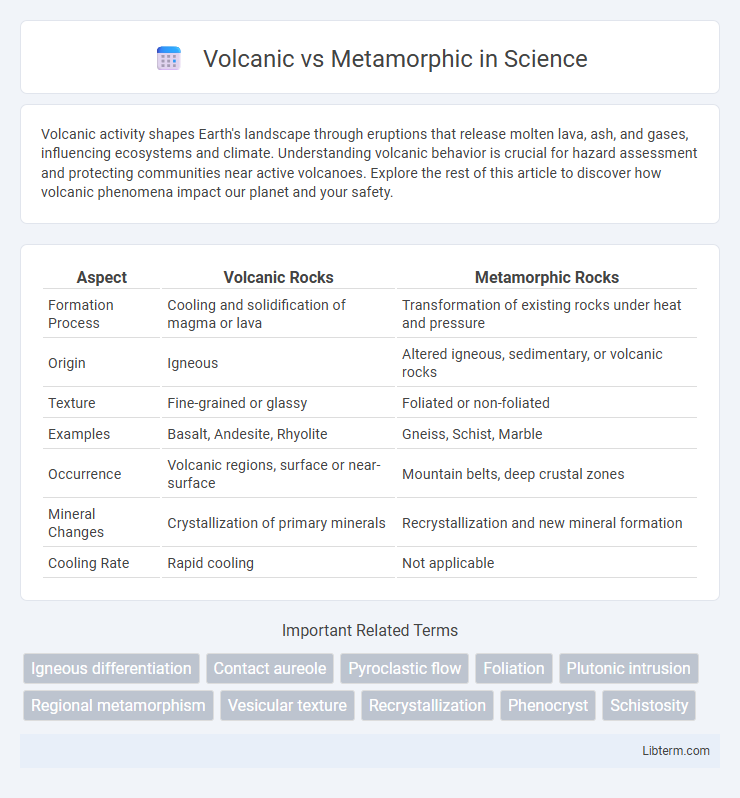Volcanic activity shapes Earth's landscape through eruptions that release molten lava, ash, and gases, influencing ecosystems and climate. Understanding volcanic behavior is crucial for hazard assessment and protecting communities near active volcanoes. Explore the rest of this article to discover how volcanic phenomena impact our planet and your safety.
Table of Comparison
| Aspect | Volcanic Rocks | Metamorphic Rocks |
|---|---|---|
| Formation Process | Cooling and solidification of magma or lava | Transformation of existing rocks under heat and pressure |
| Origin | Igneous | Altered igneous, sedimentary, or volcanic rocks |
| Texture | Fine-grained or glassy | Foliated or non-foliated |
| Examples | Basalt, Andesite, Rhyolite | Gneiss, Schist, Marble |
| Occurrence | Volcanic regions, surface or near-surface | Mountain belts, deep crustal zones |
| Mineral Changes | Crystallization of primary minerals | Recrystallization and new mineral formation |
| Cooling Rate | Rapid cooling | Not applicable |
Introduction to Volcanic and Metamorphic Rocks
Volcanic rocks form from the rapid cooling and solidification of lava on the Earth's surface, resulting in fine-grained textures and often vesicular structures. Metamorphic rocks originate from the transformation of pre-existing rocks under intense heat and pressure conditions within the Earth's crust, leading to recrystallization and mineral alignment. Understanding the formation environments and textural characteristics of these rocks is crucial for geological mapping and earth science studies.
Formation Processes: Volcanic vs Metamorphic
Volcanic rocks form through the rapid cooling and solidification of molten lava or magma at or near the Earth's surface, resulting in fine-grained or glassy textures. Metamorphic rocks develop from the transformation of existing rock types under intense heat, pressure, and chemically active fluids within the Earth's crust, causing mineralogical and structural changes without melting. The key difference lies in volcanic rocks originating from molten material, while metamorphic rocks arise from the alteration of solid pre-existing rocks.
Key Differences in Mineral Composition
Volcanic rocks primarily consist of minerals like olivine, pyroxene, and plagioclase feldspar, which cool rapidly from magma at the Earth's surface, resulting in fine-grained textures. Metamorphic rocks contain minerals such as garnet, staurolite, kyanite, and mica, formed through heat and pressure altering pre-existing rocks, leading to recrystallization and foliation. The contrasting mineral assemblages in volcanic and metamorphic rocks reflect differences in their formation environments and geochemical processes.
Texture and Appearance Comparison
Volcanic rocks exhibit a fine-grained, sometimes glassy texture due to rapid cooling of lava on the Earth's surface, resulting in smooth or vesicular appearances. Metamorphic rocks display a foliated or non-foliated texture formed by mineral recrystallization under intense heat and pressure, often showing visible banding or crystalline structures. The contrasting textures highlight volcanic rocks' extrusive origin versus metamorphic rocks' transformation deep within the crust.
Common Examples of Volcanic Rocks
Common examples of volcanic rocks include basalt, andesite, and rhyolite, which are formed from rapid cooling of lava on the Earth's surface. These fine-grained igneous rocks contrast with metamorphic rocks like schist and gneiss, which originate from the transformation of existing rocks under heat and pressure over time. Volcanic rocks typically exhibit vesicular texture due to gas bubbles trapped during solidification, distinguishing them from the crystalline textures of most metamorphic rocks.
Popular Types of Metamorphic Rocks
Popular types of metamorphic rocks include slate, schist, and gneiss, each characterized by distinct mineral compositions and foliation patterns formed under varying pressure and temperature conditions. Unlike volcanic rocks, which crystallize quickly from lava at the surface, metamorphic rocks originate from the transformation of existing rock types through heat and pressure without melting. This process results in denser, more compact rocks with unique textures used extensively in construction and decorative stone applications.
Geological Environments and Occurrences
Volcanic rocks primarily form in igneous geological environments associated with surface or near-surface volcanic activity, such as mid-ocean ridges, subduction zones, and volcanic arcs. Metamorphic rocks develop deep within the Earth's crust where intense heat and pressure alter pre-existing rocks in regions like mountain roots and continental collision zones. Volcanic rocks are commonly found in active volcanic regions, whereas metamorphic rocks dominate the cores of mountain belts and ancient continental shields.
Economic and Industrial Uses
Volcanic rocks such as basalt and pumice have significant economic uses in construction, road base materials, and lightweight aggregates, benefiting industries like infrastructure development and landscaping. Metamorphic rocks like marble and slate are highly valued for architectural applications, decorative stone, and industrial materials like roofing and flooring due to their durability and aesthetic appeal. Both rock types contribute substantially to industrial mineral extraction, with volcanic rocks often providing mineral-rich deposits and metamorphic rocks supplying valuable gemstones and industrial minerals.
Role in Earth’s Rock Cycle
Volcanic rocks, formed from cooled lava or magma, play a critical role in the Earth's rock cycle by contributing to the formation of igneous rock layers and influencing surface geology through volcanic eruptions. Metamorphic rocks originate from existing rock types subjected to high pressure and temperature, driving mineral transformation and recrystallization that alter rock texture and composition deep within the Earth's crust. Together, volcanic and metamorphic processes facilitate the continuous recycling and dynamic evolution of Earth's lithosphere.
How to Identify Volcanic and Metamorphic Rocks
Volcanic rocks can be identified by their fine-grained texture and the presence of vesicles or gas bubbles formed during rapid cooling of lava at the Earth's surface. Metamorphic rocks exhibit foliation or banding caused by intense heat and pressure altering pre-existing rocks, often showing recrystallized minerals aligned in layers. Observing grain size, texture, and mineral alignment using hand lens or microscope helps differentiate volcanic from metamorphic rocks effectively.
Volcanic Infographic

 libterm.com
libterm.com